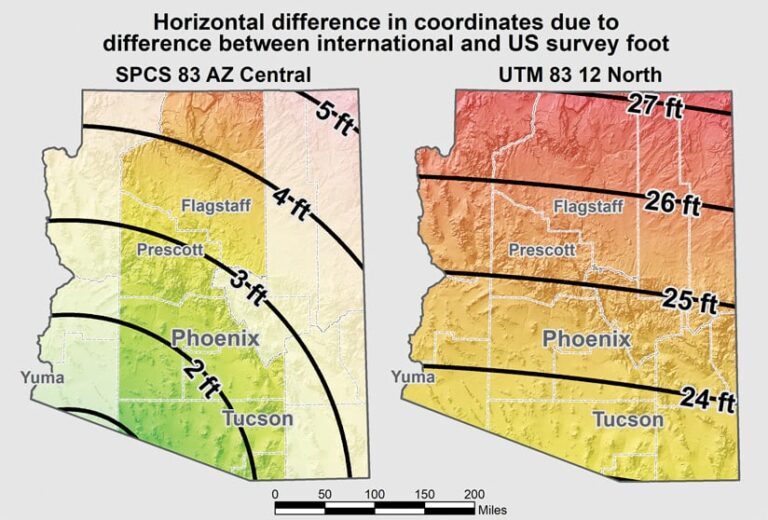For more than 60 years, the United States has had two definitions of the foot to measure length. One is the US survey foot, which dates to 1893 and is expressed as a fraction: 1200/3937 meters, or 0.3048006096… meters. The other is the slightly shorter and more exact international foot—0.3048 meters—which was adopted in 1959.
This all changed on December 31, 2022, when the National Institute of Standards and Technology (NIST) and the National Oceanic and Atmospheric Administration (NOAA) officially deprecated the US survey foot.
To most people, the difference is barely discernible and equates to approximately one-eighth of an inch per mile. But for those, like surveyors, who measure over long distances, the impact can be significant. There will be implications for GIS professionals as well.

That said, it will take a few years for the change to become permanent and for the international foot to be widely employed throughout the United States. In the meantime, Esri has verified that ArcGIS technology distinguishes between the two different definitions of a foot and is working with the National Geodetic Survey (NGS) to ensure that the international foot is fully supported in its software.
Mix-Ups Lead to Substantial Errors
Operating with two definitions of the foot was not only a nuisance, but it also posed some very real challenges for the National Spatial Reference System (NSRS), especially in state plane and other projected coordinate systems that GIS professionals frequently encounter. For decades, people have confused the two feet.
Using the wrong foot definition—the US survey foot instead of the international foot, or vice versa—can result in a substantial horizontal error. When employing the state plane coordinate system (SPCS) zones from the North American Datum of 1983 (NAD 1983) for Arizona’s Central Zone, for example, the error ranges from about one to five feet. When using universal transverse Mercator (UTM) coordinates from NAD 1983—which covers portions of Montana, Idaho, and Wyoming; all of Utah; most of Arizona; and a few surrounding areas—the error can range from 23–27 feet. The largest SPCS errors in NAD 1983, which run upwards of 50 feet, can be found in the Michigan North and Nevada East Zones. If use of the wrong foot definition is left undetected, discrepancies can result in substantial errors, such as replacing a valve on the wrong fire hydrant or even constructing a building on the wrong property.
NGS is currently recalibrating the coordinates of the NSRS to address shortcomings. As that process takes place, NGS is also collaborating with NIST and NOAA to provide a uniform definition of the foot to measure length. And the more precise international foot has prevailed.
Change Takes Time
While the deprecation of the US survey foot at the end of 2022 has a ring of finality to it, taking all the necessary steps to change over to the international foot is a process that will take time. For GIS professionals who are feeling a sense of urgency to comply with the new standard and are wondering what they should be doing, the simple answer is nothing—yet.
States that currently use the US survey foot in their state plane coordinate systems (not all of them do) need to revise their state laws to address the change in what constitutes a foot measurement. They’ll likely do this when they address the other updates being made to the NSRS. The modernized NSRS, which uses the international foot exclusively and will be called SPCS 2022, isn’t expected to be rolled out until mid-2025. Until that happens, no action needs to be taken.
If an individual state or organization elects to move to the new coordinate system earlier than that, affected GIS practitioners should verify with their organizations whether they need to convert their existing data at that time or wait for the release of SPCS 2022 and apply the international foot to data collected thereafter.
Esri is working closely with NGS in anticipation of the NSRS modernization. When NGS releases a beta version of SPCS 2022, Esri will do thorough testing to make sure that all zones are fully supported in ArcGIS software. The zones will not be added to the software, however, until NGS releases the final version, which is expected to happen in 2025.
In addition, teams at Esri already identified places in ArcGIS Pro that didn’t differentiate between the two distinct foot definitions and updated them in ArcGIS Pro 3.0. Esri technology will also continue to support the US survey foot for existing and new data collected in SPCS 83 and SPCS 27 (which is based entirely on the US survey foot).
No Need to Act—Yet
NGS has pledged to support legacy uses of the US survey foot forever for the 40 states that officially employ it for SPCS 83 and SPCS 27. However, NGS will not support the US survey foot for any zones in the state plane coordinate system come 2025, and Esri will follow suit.
As more information on the NSRS modernization becomes available, Esri will update users on how best to prepare for the change. For now, users don’t need to take any action on their own.
